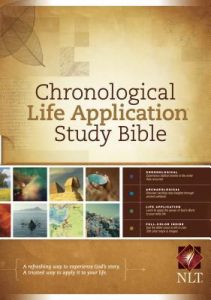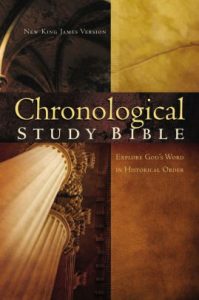Chronological bibles are a unique and helpful tool that help people understand the message of Scripture in a holistic way.
They give readers a perspective that others bibles don’t, and they do so without making any changes to the story of the Scripture or the English translation being used.

So what exactly is a chronological bible?
Chronological bibles put the books, chapters, and verses of Scripture in the historical order in which they occurred.
They don’t change, or remove, one word of Scripture, or alter English translations in any way.
They also don’t add to Scripture. Chronological bibles simply rearrange the parts of the bible that are not in the order in which they happened.
They can be read front to back like other bibles, or many people who own one use it as a reference tool to understand the chronology of, for example, the stories found in the four gospels.
The normal arrangement of biblical books is only partially in historical sequence.
Multiple sections of the bible are organized according to genre, or literary type, and even by size.
The books of Job and Psalms appear next to each other in the normal arrangement of the bible because they are both considered Hebrew poetry, also called Wisdom Literature.
Yet Job and most of the Psalms were written hundreds of years apart. Organizing books according to genre can be insightful, as can a chronological arrangement.
Also see What is a Bible Concordance? to learn more.
Chronological Bibles: Rearranging the Biblical Text
Chronological bibles help readers comprehend Scripture as a sequence of events.
For instance, the Apostle Paul’s 13 New Testament letters are mostly organized according to their size: Romans, 1 Corinthians, 2 Corinthians, and so on.
A chronological bible organizes his letters according to when he wrote them during his life and ministry.
In this format, Galatians is first, 1 and 2 Thessalonians are second and third, 1 and 2 Corinthians are fourth and fifth, and so on.
This helps readers get a holistic understanding of Paul’s life and ministry.
Old Testament Reorganization
The first difference readers of chronological bibles will notice occur after Genesis 11. Rather than continuing the story with Abraham’s biography, the book of Job appears. Why?
Because this time period is the setting for Job’s life. Normally, Job appears about half way through the Old Testament because, while it’s a story, it is told using Hebrew poetry, and so it’s grouped together with other books of similar style like Psalms and Song of Solomon.
After Job, the Old Testament story continues with the rest of Genesis as well as the first half of Exodus, which focuses on the story of Moses.
The rest of Exodus, Leviticus, Numbers, and Deuteronomy are reshaped in chronological order. Not one chapter, verse, or word is missing – they are only rearranged.
Joshua through 2 Samuel remains mostly the same because that portion of Scripture is in chronological order. In 1 and 2 Kings, however, books of Old Testament prophets appear because that is when they historically ministered.
For example, after the stories of Elijah and Elisha, the book of Obadiah appears because that’s when he ministered in Israel. Later, after the story of Josiah is told, the book of Jeremiah appears because that’s when he ministered.
With a chronological bible, the timeline of the Old Testament is more clearly seen. Rather than being grouped according to literary type, books are arranged according to significant events, such as books that were written before the exile (e.g. 1 and 2 Samuel, Joel, Amos), during the exile (e.g. Ezekiel, the end of Jeremiah’s ministry, Daniel), and after the exile (e.g. Esther, Nehemiah, Haggai).
New Testament Reorganization

In the New Testament, the gospels are significantly reordered. The genealogies of Jesus appear first, both Matthew’s and Luke’s, followed by the birth stories of Jesus, both Matthew’s and Luke’s.
As the story continues, the gospel writers’ stories are grouped together and the reader benefits from studying the greatest life ever lived in sequential order. It also provides great insight to read the same stories from different gospel writers back-to-back because the authors never tell the stories in the exact same way.
One eye-opening example of this is being able to read in order the last week of Jesus’ life. Since each gospel gives different, though not contradictory accounts, the reader doesn’t receive the full version from any author.
This is not unlike interviewing four people who were eye-witnesses to an event. Each would have their own way of telling a story, though there would be some overlap. Being able to group the eye-witness accounts together would offer profound understanding. Acquiring such insight about the most important week is history is worth the time and effort.
The timeline of the book of Acts and the timeline of the Paul’s life, ministry, and writings overlap. In chronological bibles, Acts doesn’t appear in the normal order, from chapter one to 28.
Instead, for example, after Acts 15, in which the story of the Jerusalem Council is told, the book of Galatians follows it, because that is when Paul wrote it.
Paul then sets out on his second missionary journey, referenced in Acts 15, which is followed by 1 and 2 Thessalonians since he wrote those letters on that trip.
After Acts and the story of Paul, the remaining New Testament books, like James, Jude, 1 and 2 Peter, and 1-3 John appear. Like normally-arranged bibles, Revelation concludes chronically-arranged bibles, too.
Examples of Well-Reviewed Chronological Bibles
The bibles below represent a few of the best-reviewed Chronological bibles available today. Publishers have incorporated the most loved English translations and utilized some the best biblical scholars to make these projects come to life.
Chronological Life Application Study Bible – New Living Translation
Get this book on: Amazon | Christian Book Distributors


Features:
- 2013 ECPA Christian Book Award winner
- Organized into 10 eras of biblical history in chronological order
- Includes Life Application
- Also available in the KJV
The Chronological Study Bible – New King James Version
Get this book on: Amazon | Christian Book Distributors


Features:
- The Chronological Study Bible presents the text of the NKJV in chronological order
- Includes notes, articles, and full-color graphics
- Also available in the NIV
The Reese Chronological Study Bible – King James Version
Get this book on: Amazon | Christian Book Distributors


Features:
- Presents the King James Version in historical order
- includes in-depth study materials
Narrated Bible in Chronological Order – New International Version
Get this book on: Amazon


Features:
- The laws of Moses presented together in one unified legal code arranged by subject
- The wisdom literature—including Proverbs—presented topically
- The four Gospels gathered together in one harmonious account
- Paul’s epistles integrated and presented within the historical record of Acts
The Daily Bible – New International Version
Get this book on: Amazon | Christian Book Distributors


Features:
From the publisher: Reading through the Bible can be a challenge as you try to navigate the traditional arrangement of its 66 books. The Daily Bible® makes it simple by organizing the whole of Scripture in chronological order, as well as presenting Proverbs topically and the Psalms by themes. This beloved presentation of the New International Version (NIV) includes introductory narration that sets the scene for each passage and provides rich spiritual insights. As you journey through the 365 daily readings, you will:
- grasp the historical context and unfolding story of Scripture more clearly
- accomplish your goal of reading through the entire Bible in a year
- find your relationship with God strengthened and nourished as never before
